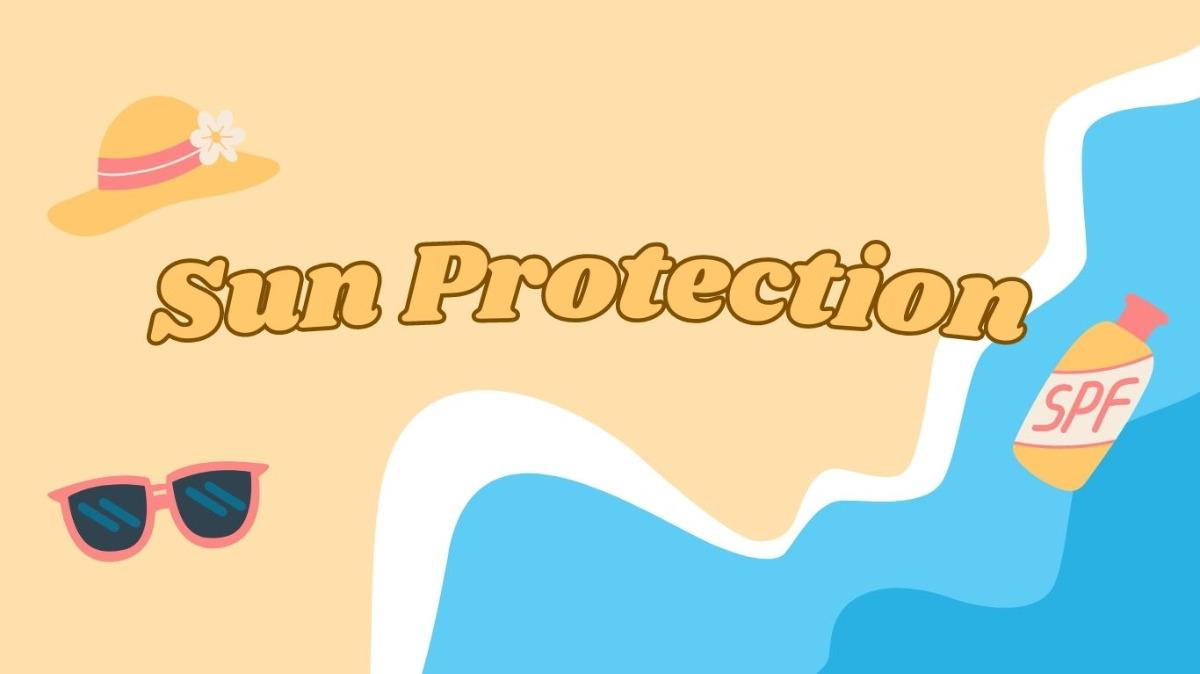Sun Protection

- posted: Jul. 11, 2023
During the summer months, children are likely to spend more time outside in the sun. Though we encourage their determination to go outside and be active, this also puts them at an increased risk for developing sunburns and acquiring prolonged sun exposure. Blistering sunburns and extended exposure to the sun’s ultraviolet (UV) rays increase our likelihood of developing skin cancer. Residents of Hawaii have an even higher risk of skin cancer due to our close proximity to the equator. Therefore, using sun protection is extremely important for children to learn and establish as part of their routine.
What can we do to protect our skin and decrease our chance of developing skin cancer? Avoid the sun during its peak hours between 10AM-4PM. Use sunscreen with SPF30+. Reapply sunscreen every 1-2 hours and after getting the skin wet. Look for a broad spectrum or UVA/UVB protection in sunscreens. Mineral sunscreens (zinc, titanium) are preferred and safer than chemical sunscreens (oxybenzone, octocrylene, etc.) for both our health and the reef environments. Sunscreen is not recommended for infants under 6 months of age due to a greater risk for side effects. Infants’ skin is more sensitive to serious sunburns so it is important that other sun protection precautions are used. Proper clothing can help protect infants and children from dangerous sun exposure. Helpful pieces of clothing include long sleeve shirts, wide brimmed hats, and sunglasses. Different clothing materials offer different levels of protection. Polyester clothing offers better protection than cotton. Darker colors also offer more protection than lighter colors.
Not all sun exposure is bad. The sun’s UV rays stimulate the synthesis of bioavailable Vitamin D within the body. Vitamin D is important because it helps the body absorb calcium from our diet. Calcium is necessary to form strong bones. Therefore sun-induced Vitamin D synthesis is beneficial to our bodies. Though Vitamin D is important, sun protection can decrease the amount synthesized within the body. The risk of skin cancer from these UV rays outweighs the benefits so it is still vital that sun protection is used whenever exposed to sunlight. Vitamin D can be obtained through supplements and certain foods like tuna, salmon, mackerel, egg yolk, and Vitamin D-fortified foods such as milk and orange juice.
Children should know about the dangers of increased sun exposure and how to properly protect themselves. This way they can stay active outdoors and away from the screens in a safe and healthy manner.

- posted: Jul. 11, 2023
During the summer months, children are likely to spend more time outside in the sun. Though we encourage their determination to go outside and be active, this also puts them at an increased risk for developing sunburns and acquiring prolonged sun exposure. Blistering sunburns and extended exposure to the sun’s ultraviolet (UV) rays increase our likelihood of developing skin cancer. Residents of Hawaii have an even higher risk of skin cancer due to our close proximity to the equator. Therefore, using sun protection is extremely important for children to learn and establish as part of their routine.
What can we do to protect our skin and decrease our chance of developing skin cancer? Avoid the sun during its peak hours between 10AM-4PM. Use sunscreen with SPF30+. Reapply sunscreen every 1-2 hours and after getting the skin wet. Look for a broad spectrum or UVA/UVB protection in sunscreens. Mineral sunscreens (zinc, titanium) are preferred and safer than chemical sunscreens (oxybenzone, octocrylene, etc.) for both our health and the reef environments. Sunscreen is not recommended for infants under 6 months of age due to a greater risk for side effects. Infants’ skin is more sensitive to serious sunburns so it is important that other sun protection precautions are used. Proper clothing can help protect infants and children from dangerous sun exposure. Helpful pieces of clothing include long sleeve shirts, wide brimmed hats, and sunglasses. Different clothing materials offer different levels of protection. Polyester clothing offers better protection than cotton. Darker colors also offer more protection than lighter colors.
Not all sun exposure is bad. The sun’s UV rays stimulate the synthesis of bioavailable Vitamin D within the body. Vitamin D is important because it helps the body absorb calcium from our diet. Calcium is necessary to form strong bones. Therefore sun-induced Vitamin D synthesis is beneficial to our bodies. Though Vitamin D is important, sun protection can decrease the amount synthesized within the body. The risk of skin cancer from these UV rays outweighs the benefits so it is still vital that sun protection is used whenever exposed to sunlight. Vitamin D can be obtained through supplements and certain foods like tuna, salmon, mackerel, egg yolk, and Vitamin D-fortified foods such as milk and orange juice.
Children should know about the dangers of increased sun exposure and how to properly protect themselves. This way they can stay active outdoors and away from the screens in a safe and healthy manner.
Monday
8:00 am - 12:00 pm
1:15 pm - 5:00 pm
Tuesday
8:00 am - 12:00 pm
1:15 pm - 5:00 pm
Wednesday
8:00 am - 12:00 pm
Thursday
8:00 am - 12:00 pm
1:15 pm - 5:00 pm
Friday
8:00 am - 12:00 pm
1:15 pm - 5:00 pm
Saturday
Closed
Sunday
Closed